Mindfulness meditation techniques offer effective stress relief and emotional balance. These practices include breath awareness, body scans, and loving-kindness meditation. They help individuals process emotions and enhance present-moment awareness. Regular engagement can lead to significant improvements in mental health and resilience against stressors.

How do mindfulness meditation techniques alleviate stress?
Mindfulness meditation techniques effectively alleviate stress by promoting relaxation and enhancing emotional balance. These practices help individuals focus on the present moment, reducing anxiety and fostering a sense of calm. Techniques such as focused breathing, body scans, and mindful observation encourage awareness of thoughts and feelings without judgment. As a result, practitioners often experience lower cortisol levels, which is a key stress hormone. Regular engagement in mindfulness meditation can lead to long-term improvements in mental health and resilience against stressors.
What are the physiological effects of mindfulness meditation on stress levels?
Mindfulness meditation significantly reduces stress levels by promoting relaxation and enhancing emotional regulation. Research shows that regular practice lowers cortisol levels, which are linked to stress. Additionally, mindfulness techniques improve focus and increase awareness of thoughts, leading to better coping strategies. A study found that participants practicing mindfulness experienced a 30% reduction in perceived stress after eight weeks. These physiological changes contribute to overall emotional balance and well-being.
Which mindfulness meditation techniques are most effective for immediate stress relief?
Mindfulness meditation techniques such as focused breathing, body scan, and loving-kindness are effective for immediate stress relief. Focused breathing reduces anxiety by anchoring attention to the breath. Body scan promotes relaxation by increasing awareness of bodily sensations. Loving-kindness fosters emotional balance by cultivating compassion towards oneself and others. These techniques can be practiced anywhere, making them accessible tools for managing stress.
How does regular practice impact long-term stress management?
Regular practice of mindfulness meditation significantly enhances long-term stress management. It cultivates emotional balance, reduces anxiety, and promotes resilience against stressors. Studies show that consistent meditation can decrease cortisol levels, leading to improved overall well-being. Furthermore, individuals who practice regularly report heightened awareness and better emotional regulation, contributing to a more balanced life.
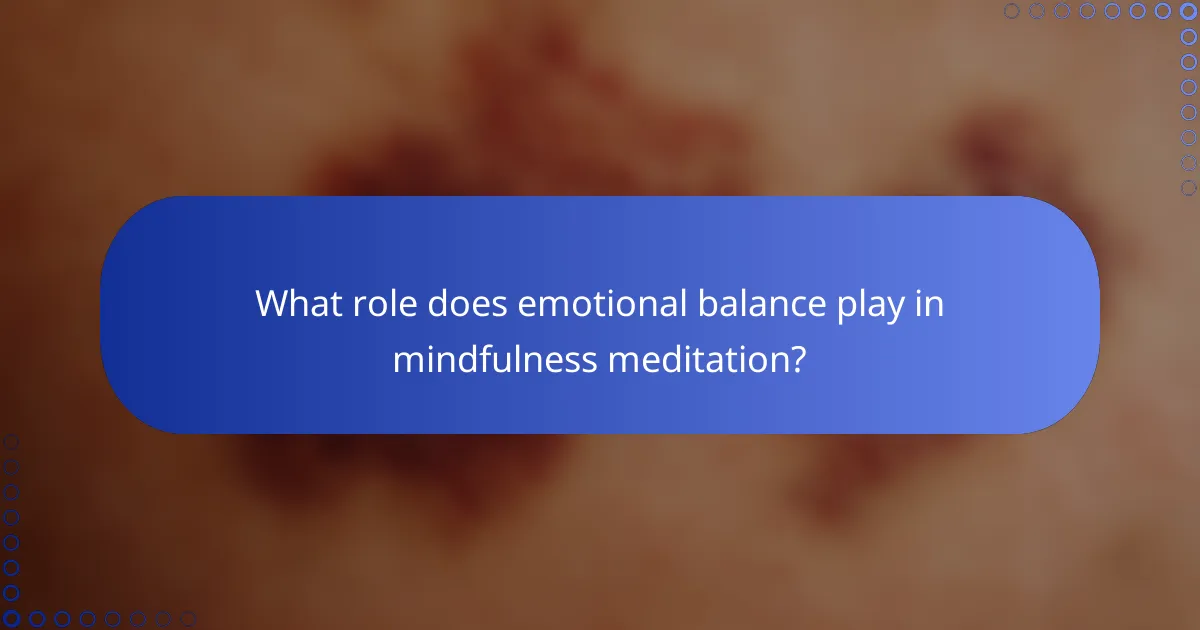
What role does emotional balance play in mindfulness meditation?
Emotional balance is crucial in mindfulness meditation as it enhances stress relief and overall well-being. Mindfulness practices cultivate awareness of emotions, allowing individuals to process feelings without judgment. This leads to greater emotional regulation and resilience. Research indicates that regular mindfulness meditation can reduce anxiety and improve mood stability, contributing to lasting emotional balance. By fostering a non-reactive mindset, practitioners can experience a heightened sense of calm and clarity in daily life.
How can mindfulness meditation improve emotional regulation?
Mindfulness meditation significantly enhances emotional regulation by fostering awareness and acceptance of emotions. This practice encourages individuals to observe their feelings without judgment, leading to improved self-control and resilience. Research indicates that regular mindfulness meditation can reduce stress levels, promote emotional stability, and increase overall well-being. By training the mind to focus on the present, individuals can better manage their emotional responses, resulting in healthier coping mechanisms and reduced anxiety.
Which techniques foster emotional resilience through mindfulness?
Mindfulness techniques that foster emotional resilience include body scan meditation, loving-kindness meditation, and mindful breathing. These practices enhance self-awareness and emotional regulation, leading to greater stress relief and emotional balance.
Body scan meditation promotes awareness of physical sensations, helping individuals connect with their emotions. Loving-kindness meditation cultivates compassion and empathy, fostering a positive mindset. Mindful breathing centers attention on the present moment, reducing anxiety and enhancing emotional stability.
Incorporating these techniques into daily routines can significantly improve emotional resilience and overall well-being. Regular practice leads to increased mindfulness, helping individuals navigate life’s challenges with greater ease.
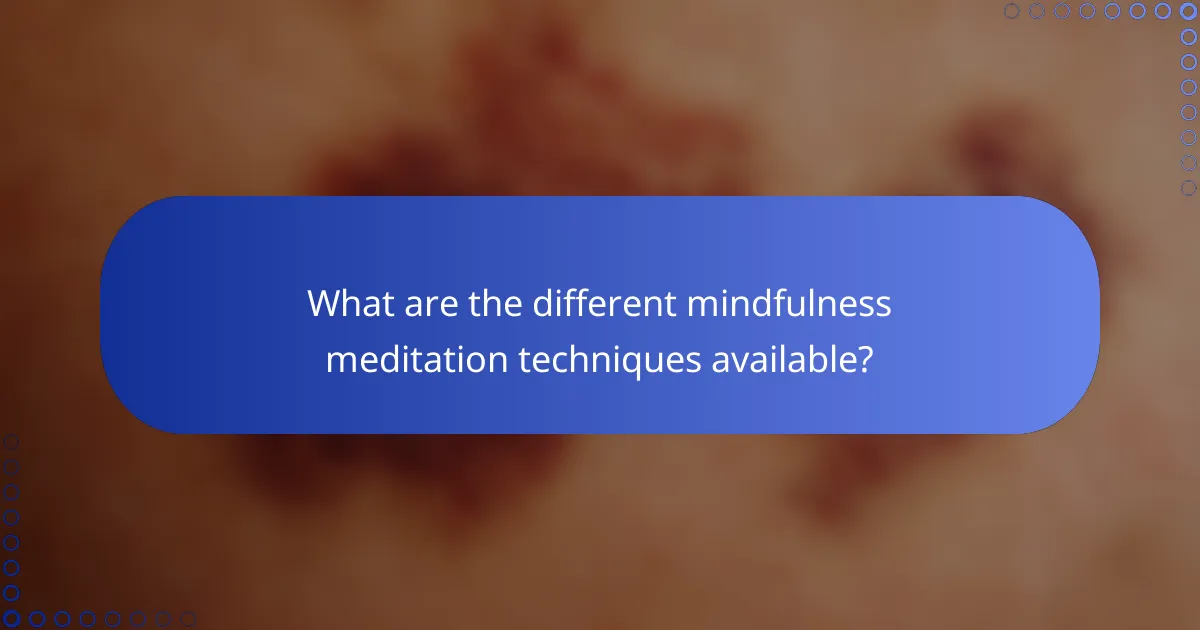
What are the different mindfulness meditation techniques available?
Mindfulness meditation techniques include various practices that promote stress relief and emotional balance. These techniques vary in focus and application, catering to different preferences.
1. Breath Awareness: Focus on the natural rhythm of breathing to enhance present-moment awareness.
2. Body Scan: Systematically observe bodily sensations to foster relaxation and connection with the body.
3. Loving-Kindness Meditation: Cultivate compassion and love towards oneself and others through positive affirmations.
4. Guided Visualization: Use imagery and narration to evoke calming scenes, aiding in relaxation and mental clarity.
5. Mindful Movement: Incorporate gentle physical activity, such as yoga or tai chi, to integrate mindfulness with movement.
6. Mantra Meditation: Repeat a specific word or phrase to center the mind and reduce distractions.
How do guided meditations differ from unguided practices?
Guided meditations provide direction and structure, while unguided practices allow for personal exploration. Guided sessions often include specific instructions, themes, or visualizations, which can enhance focus and reduce stress. In contrast, unguided practices promote self-awareness and individual pacing, fostering emotional balance through personal insight. Both techniques serve to alleviate stress, but their approaches cater to different preferences and needs in mindfulness meditation.
What is the significance of breath-focused meditation in mindfulness?
Breath-focused meditation is significant in mindfulness as it enhances emotional balance and reduces stress. This technique directs attention to the breath, fostering present-moment awareness. As a result, practitioners experience decreased anxiety and improved focus. Studies indicate that consistent practice can lead to structural changes in the brain associated with emotional regulation. Breath-focused meditation serves as a foundational technique in mindfulness, making it accessible for beginners and effective for stress relief.
Which body scan techniques enhance awareness and reduce tension?
Body scan techniques enhance awareness and reduce tension by promoting mindfulness and relaxation. Practices like the body scan meditation involve systematically focusing on different body parts, encouraging deep breathing and present-moment awareness. This technique can lead to reduced stress and improved emotional balance, as it helps individuals connect with their physical sensations and release tension. Regular practice can increase self-awareness and foster a sense of calm, making it a valuable tool for stress relief.
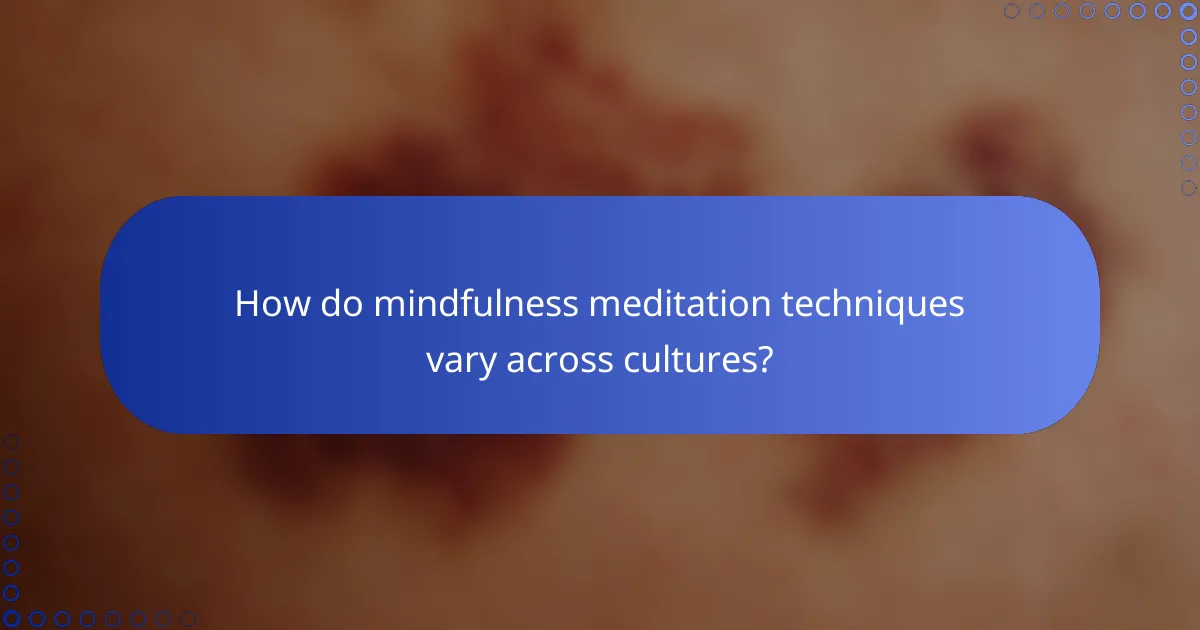
How do mindfulness meditation techniques vary across cultures?
Mindfulness meditation techniques vary significantly across cultures, reflecting distinct practices and philosophies. For example, Zen Buddhism emphasizes breath awareness and simplicity, while Tibetan Buddhism incorporates visualization and chanting. In Western contexts, mindfulness often focuses on cognitive behavioral strategies to enhance emotional balance. These cultural differences highlight unique attributes of mindfulness practices that cater to specific community needs and beliefs.
What unique approaches to mindfulness exist in Eastern traditions?
Unique approaches to mindfulness in Eastern traditions include Zen meditation, Vipassana, and loving-kindness meditation. Zen meditation emphasizes direct experience and present awareness, fostering clarity and insight. Vipassana focuses on insight into the nature of reality through deep observation of thoughts and sensations. Loving-kindness meditation cultivates compassion and emotional balance by promoting goodwill towards oneself and others. Each technique offers distinct benefits for stress relief and emotional well-being, enriching the practice of mindfulness.
How has Western adaptation transformed traditional mindfulness practices?
Western adaptation has significantly transformed traditional mindfulness practices by incorporating diverse techniques for stress relief and emotional balance. This evolution emphasizes practicality, making mindfulness accessible to a broader audience.
Modern mindfulness often integrates cognitive-behavioral approaches, enhancing emotional regulation. Techniques such as guided meditation and mindful breathing exercises are now prevalent, promoting immediate stress relief. Research shows that these adaptations can reduce anxiety levels by up to 60%, demonstrating their effectiveness.
Furthermore, the incorporation of technology, like mindfulness apps, has revolutionized practice. These platforms offer tailored experiences, making mindfulness more engaging. As a result, practitioners can access a variety of techniques that suit their individual needs.
Overall, Western adaptation has enriched traditional mindfulness, making it a versatile tool for emotional balance and stress management.
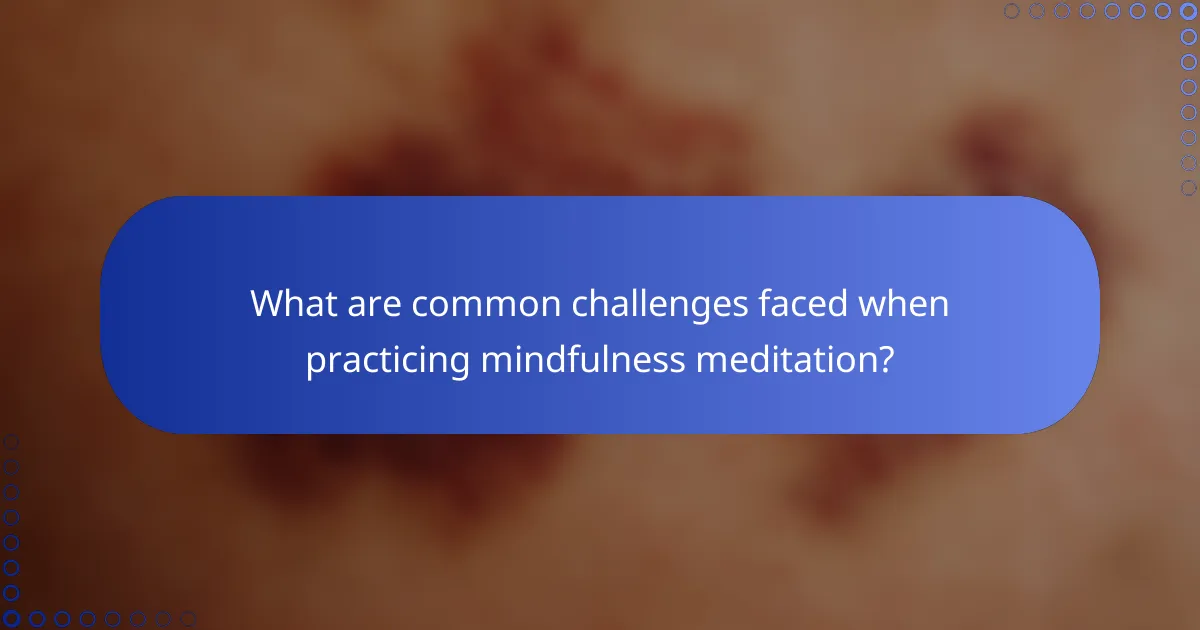
What are common challenges faced when practicing mindfulness meditation?
Common challenges in practicing mindfulness meditation include distractions, difficulty maintaining focus, and emotional discomfort. These obstacles can hinder the effectiveness of mindfulness techniques for stress relief and emotional balance. Distractions often arise from external noise or internal thoughts, making it hard to concentrate. Maintaining focus requires consistent practice, which can be challenging for beginners. Additionally, confronting uncomfortable emotions during meditation may lead to avoidance rather than acceptance, complicating the process. Addressing these challenges is essential for enhancing mindfulness meditation’s benefits.
How can distractions be managed during meditation sessions?
To manage distractions during meditation sessions, focus on creating a conducive environment. Establish a quiet space, eliminate interruptions, and set a specific time for practice. Incorporate techniques like mindful breathing, acknowledging thoughts without judgment, and gently redirecting attention back to the breath or body sensations. Regular practice enhances concentration, making it easier to minimize distractions over time.
What strategies help maintain motivation for regular practice?
Establishing a routine, setting clear goals, and tracking progress are key strategies to maintain motivation for regular mindfulness meditation practice. Consistency builds habit, while specific objectives provide direction. Using a journal or app to monitor sessions reinforces commitment and highlights progress. Engaging with a community or finding an accountability partner can enhance motivation through shared experiences and support.
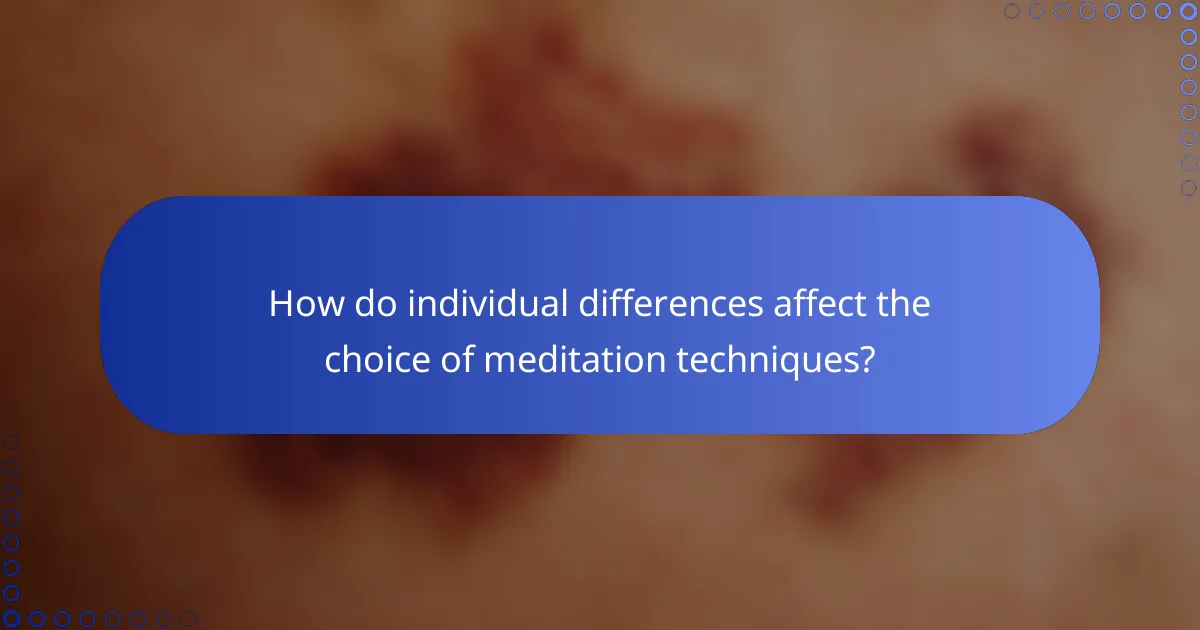
How do individual differences affect the choice of meditation techniques?
Individual differences significantly influence the choice of meditation techniques. Factors such as personality traits, stress levels, and past experiences shape preferences for specific mindfulness practices.
For instance, individuals with high anxiety may favor guided meditations that provide structure, while those seeking emotional balance might prefer open-awareness techniques. Personal goals also play a critical role; some may prioritize relaxation, while others focus on self-discovery or emotional regulation.
Additionally, cultural background can impact meditation style preferences, as certain techniques may resonate more deeply with specific cultural values or beliefs. Understanding these differences helps tailor meditation practices to enhance effectiveness and satisfaction.
What factors influence the effectiveness of mindfulness for different personalities?
Mindfulness effectiveness varies by personality traits, influencing stress relief and emotional balance. Factors include openness to experience, emotional stability, and conscientiousness. Individuals high in openness often embrace mindfulness practices more readily, enhancing their benefits. Conversely, those lower in emotional stability may experience challenges in maintaining focus, reducing effectiveness. Conscientious individuals may apply mindfulness techniques consistently, leading to better outcomes. Understanding these traits can help tailor mindfulness approaches for optimal results.
How do age and lifestyle impact the selection of meditation practices?
Age and lifestyle significantly influence the selection of mindfulness meditation techniques. Older individuals may prefer gentler practices like guided meditations, while younger practitioners might explore dynamic forms such as movement-based meditation.
Lifestyle factors, such as stress levels and daily routines, also dictate choices. Busy professionals may opt for shorter, focused sessions to fit their schedules, whereas retirees might engage in longer, immersive practices.
The effectiveness of meditation techniques can vary based on these attributes. For instance, mindfulness techniques that emphasize breathing may benefit individuals with high stress, regardless of age.
Ultimately, personal preferences and life circumstances guide the selection of meditation practices, ensuring they align with individual needs and goals.
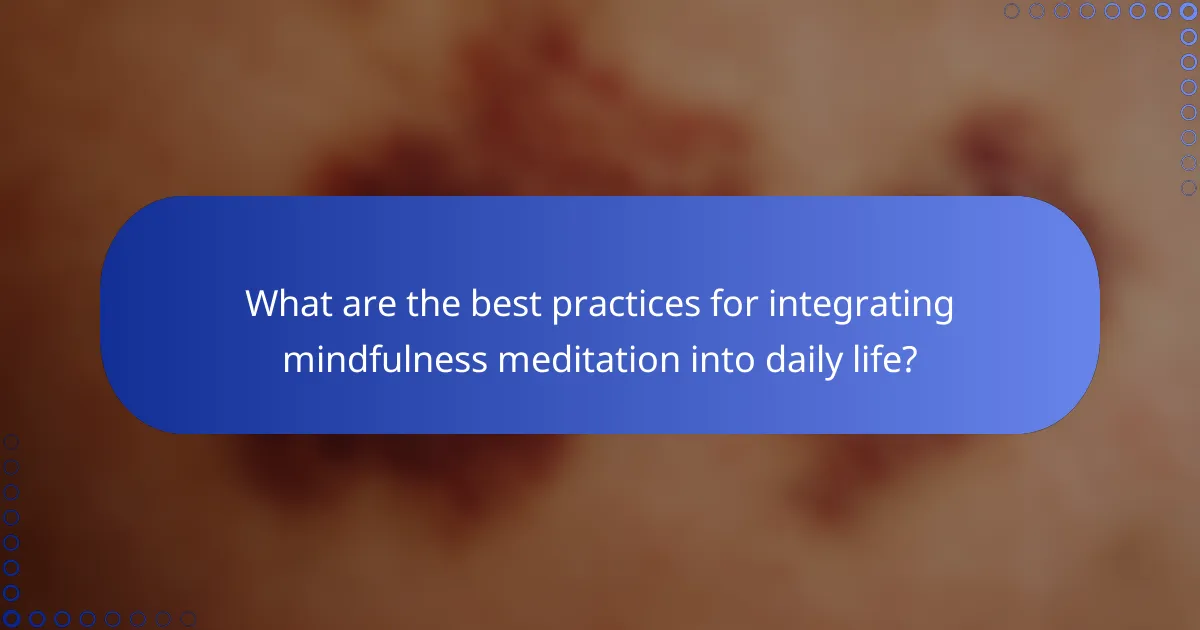
What are the best practices for integrating mindfulness meditation into daily life?
Integrating mindfulness meditation into daily life involves consistent practice and intentionality. Start with short sessions, gradually increasing duration as comfort grows.
1. Establish a routine: Choose a specific time each day for meditation.
2. Create a dedicated space: Find a quiet area free from distractions.
3. Use guided meditations: Leverage apps or online resources for structure.
4. Practice mindful breathing: Focus on your breath to enhance awareness.
5. Incorporate mindfulness into daily activities: Engage fully in tasks like eating or walking.
6. Reflect on your practice: Journal insights or feelings post-meditation to track progress.
These practices foster emotional balance and reduce stress, enhancing overall well-being.
How can mindfulness be incorporated into routine activities?
Mindfulness can be easily incorporated into routine activities by focusing on the present moment and engaging fully in each task. Practicing mindfulness during daily activities enhances stress relief and emotional balance. For example, while eating, concentrate on the flavors and textures of the food. During walking, pay attention to each step and your surroundings. Incorporating short mindfulness breaks throughout the day, such as deep breathing or a few minutes of meditation, can also enhance overall well-being. Engaging in these practices consistently helps establish a habit of mindfulness in everyday life.
What tips enhance the effectiveness of mindfulness meditation sessions?
To enhance the effectiveness of mindfulness meditation sessions, focus on consistency, environment, and technique. Establish a regular practice schedule to build habit and deepen mindfulness. Choose a quiet, comfortable space free from distractions to promote relaxation. Incorporate techniques like breath awareness, body scanning, and loving-kindness to enrich the experience.
What common mistakes should be avoided when starting mindfulness meditation?
Avoiding common mistakes in mindfulness meditation enhances stress relief and emotional balance. Key errors include skipping practice consistency, focusing on outcomes instead of the process, and being overly critical of one’s thoughts. Additionally, neglecting to create a conducive environment can hinder effectiveness. Lastly, comparing progress with others detracts from personal growth.